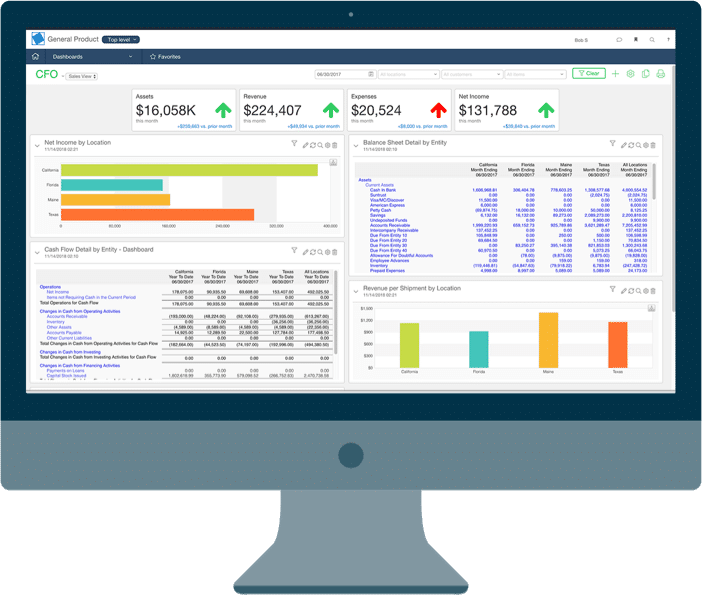Fixed asset software is a crucial tool for businesses of all sizes. It helps companies manage and track their physical assets, such as equipment, buildings, and vehicles.
In today’s fast-paced business environment, it is essential to have a reliable and efficient way to manage fixed assets.
This article will delve into the significance of employing software for fixed asset management, the drawbacks of relying on spreadsheets or manual methods, the benefits of utilizing cloud-based fixed asset software, the necessity of distinguishing between accounting fixed asset treatment and tax fixed asset treatment, and the importance of integrating fixed asset software with other accounting and tax platforms.
Fixed asset software instead of spreadsheets
The importance of using software to manage fixed assets cannot be overstated. Without proper management, fixed assets can become a liability rather than an asset. Software solutions provide businesses with the tools they need to track, maintain, and dispose of their fixed assets. This includes tracking the acquisition and disposal of assets, as well as maintaining accurate records of their location, condition, and value. By using software, businesses can ensure that their fixed assets are being used effectively and efficiently.
Using spreadsheets or other manual processes to manage fixed assets can be risky and inefficient. Spreadsheets are prone to errors, and it can be difficult to keep them up-to-date. Manual processes are also time-consuming, and it can be challenging to ensure that all of the necessary information is included. With software solutions, businesses can automate many of the tasks associated with fixed asset management, saving time and reducing the risk of errors.
Fixed asset software in the cloud
Cloud-based fixed asset software has many advantages over desktop-based solutions.
Cloud-based software is accessible from any device with an internet connection, making it easy for employees to access and update information from anywhere.
This can be particularly beneficial for businesses with multiple locations or employees who work remotely.
Cloud-based solutions also typically have lower upfront costs, as there is no need to purchase and install software on individual computers.
Additionally, with cloud-based software, businesses can take advantage of automatic updates and backups, ensuring that their data is always up-to-date and secure.
AssetAccountant – saving you from spreadsheets since 2019
Tax vs Accounts for fixed asset depreciation
Differentiating between accounting fixed asset treatment and tax fixed asset treatment is essential for businesses.
Accounting fixed asset treatment refers to how assets are recorded on a company’s financial statements, while tax fixed asset treatment refers to how assets are treated for tax purposes.
It is important to understand the difference between the two, as they can have a significant impact on a company’s financial and tax position.
Software solutions can help businesses navigate these differences by providing the necessary tools to properly record and report fixed assets for both accounting and tax purposes.
Software integrations with GLs and ERPs
Integrating fixed asset software with other accounting and tax platforms is important for businesses.
By integrating with other software, businesses can streamline their processes and reduce the risk of errors.
For example, by integrating fixed asset software with accounting software, businesses can ensure that the information recorded in both systems is accurate and up-to-date.
Additionally, by integrating fixed asset software with tax software, businesses can ensure that their fixed asset information is properly reported for tax purposes.
We take depreciation and leasing seriously
We undertake detailed modelling of fixed asset depreciation and lease calculation rules for both accounting and tax.
We monitor changes to ATO tax rulings and accounting standards like IAS 16 and IFRS 16 so you don’t have to.
And, of course, we are ISO27001 certified.
We take depreciation and leasing seriously
We undertake detailed modelling of fixed asset depreciation and lease calculation rules for both accounting and tax.
We monitor changes to IRS tax rulings and accounting standards like US GAAP and ASC 842 so you don’t have to.
And, of course, we are ISO27001 certified.
We take depreciation and leasing seriously
We undertake detailed modelling of fixed asset depreciation and lease calculation rules for both accounting and tax.
We monitor changes to IRD tax rulings and accounting standards like IFRS 16 so you don’t have to.
And, of course, we are ISO27001 certified.
We take depreciation and leasing seriously
We undertake detailed modelling of fixed asset depreciation and lease calculation rules for both accounting and tax.
We monitor changes to tax rulings and accounting standards like IFRS and US GAAP so you don’t have to.
And, of course, we are ISO27001 certified.
Why our clients love AssetAccountant


Fantastic product - has literally saved me hours of work.


Ever wanted the big company fixed asset system without all the clunkiness and overthinking on the part of the software developers (I'm looking at you Thomson Reuters...)? Well then you need AssetAccountant. It provides just the right mix of complex depreciation calculations and beautiful user interface. It's a system designed by accountants and executed perfectly by developers. The integration is seamless with Xero (you can sign into AA with Xero credentials which is awesome if you are already running Xero on your browser) and journaling synchs are very flexible between the two applications. Then there is the price. I challenge you to find a more robust fixed asset system at these price points. Well done AssetAccountant.
You get me.
I now have my big boy jocks back on for fixed asset management....and they fit!









Evaluating different fixed asset software solutions
Asset tracking: The software should be able to track and maintain accurate records of all of your fixed assets, including their location, condition, and value.
Reporting: The software should be able to generate reports on your fixed assets, including acquisition and disposal reports, as well as reports on the location and condition of your assets.
Integration: The software should be able to integrate with other accounting and tax platforms, such as accounting software and tax software.
Security: The software should be able to protect your data and ensure that it is kept confidential.
Automation: One of the key features of a good fixed asset software solution is its ability to automate many of the tasks associated with fixed asset depreciation and lease accounting. This can save time and reduce the risk of errors. For example, the software should be able to automatically generate reports and update asset information, in bulk actions.
Accuracy: Up-to-date information on your fixed assets is essential. This can be particularly important for businesses that need to comply with regulatory requirements or that have a large number of assets. With accurate information, businesses can make better decisions about their assets and ensure that they are being used effectively and efficiently.
In summary
Fixed asset software is a crucial tool for businesses of all sizes.
It allows them to manage and track their physical assets, such as equipment, buildings, and vehicles.
With software, businesses can ensure that their fixed assets are being used effectively and efficiently.
Cloud-based fixed asset software has many advantages over desktop-based solutions and differentiating between accounting fixed asset treatment and tax fixed asset treatment is essential for businesses.
Integrating fixed asset software with other accounting and tax platforms can also streamline processes and reduce the risk of errors.


Ready to kick some assets?
- AssetAccountant is fixed asset software that automates fixed asset depreciation & lease accounting and posts their journals to the General Ledger.
- AssetAccountant combines detailed interpretation of Tax and Accounting rules with a modern user interface design, to simplify the process of creating and maintaining your fixed asset register.
- AssetAccountant is sophisticated enough for Wall Street, user-friendly enough for main street.
- AssetAccountant is for worldwide application 🌎













































